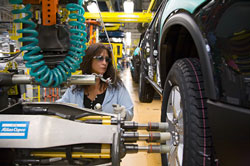Changing the Auto Industry from the Wheels Up
The problems of the U.S. auto industry call for radical solutions.
This is a web-only article from the website of Dollars & Sense: The Magazine of Economic Justice available at http://www.dollarsandsense.org

This is a web-only article, available only at www.dollarsandsense.org.
Subscribe Now
at a 30% discount.
Intro | Pt. I | Pt. II | Pt. III | Pt. IV | Pt. V | Pt. VI Full article

Photo by Jim West
Part V: Industrial Conversion
The number of cars being produced should go down, especially for environmental reasons, and resources should be directed to environmentally sustainable industries.
The government could keep auto workers employed producing exactly what they have been producing—by nationalizing the companies, buying assets like factories and machinery, or some other policy—but that should not be the objective. Cars, especially the gas-guzzling SUVs, pickup trucks, and high-horsepower cars that the Big Three have been cranking out, are an environmental and public-health disaster. They generate tons of pollution, waste vast energy resources, require huge amounts of space and infrastructure to store and operate, and pose grave danger to other users of public roads (including other motorists, cyclists, and pedestrians).
Producing these vehicles has also turned out to be a bad business plan. The Big Three bet heavily on large, gas-guzzling vehicles that had until recently been high-profit items. All three companies actually sell substantially more “light trucks”—pickups, SUVs, vans, and minivans—than cars. In 2008, light trucks accounted for nearly 60% of GM’s new vehicle sales; for Ford, nearly 65%; for Chrysler, over 70%. (Meanwhile, they accounted for about 40% of Toyota, Honda, and Nissan’s new vehicle sales.) [Note 58] Last year’s spike in fuel prices hit U.S. automakers especially hard. Both company officials and industry analysts recognized, however, that the demand for smaller, more fuel-efficient vehicles was more than just a temporary “spike.” U.S. consumers were shifting permanently toward smaller vehicles, and the Big Three had been caught behind the times. [Note 59]
The world auto industry suffers from chronic overcapacity. [Note 60] Auto companies have made huge investments in plant and equipment. Once these investments have been made, the companies pay these costs regardless of the number of cars they produce, so these are referred to as “fixed” costs. (Imagine a company that has signed a lease on a factory, for example, and has to pay the rent whether it produces one vehicle or a thousand.) If an auto company does not operate near capacity, the production cost per car goes up, as those fixed costs are averaged over a smaller number of cars. [Note 61] As a result, the auto companies have persisted in producing too many cars, resulting in enormous inventories and, for some companies, the sale of cars at a loss.
It is not a bad thing for auto production to decline. The U.S. auto companies, however, are now cutting production in an incredibly wrenching fashion, which is decimating employment and union membership in auto manufacturing, parts manufacturing, and auto and parts sales. Employment in auto and auto-parts manufacturing in the Untied States has declined by over 210,000 over the last year, and at auto and auto-parts dealerships by an additional 190,000. [Note 62] The government, meanwhile, has encouraged layoffs by requiring deep cuts in company costs as a condition of the bailout.
Instead of overseeing this bloodletting, the government could oversee a process of shifting workers and physical resources to environmentally sustainable branches of production with a minimum of disruption, insecurity, and pain. Existing plant and equipment could certainly be used (with retooling) to produce more fuel-efficient cars, hybrid cars, or electric cars. This is already in the cards to some degree. The government made improved fuel efficiency a condition of the initial bailouts last year, [Note 63] and the Fiat takeover plan includes incentives that will increase the company’s equity stake in Chrysler if it meets goals for the development of more fuel-efficient vehicles. [Note 64] GM has a primarily electric car (with a backup gasoline engine), the Chevy Volt, in the works for 2010, though some analysts have questioned design decisions that have contributed to the Volt’s high projected price. The company has also promised to develop 15 hybrid models by 2012. Ford has described plans for an electric van for 2010, with other hybrid and electric vehicles to follow by 2012. Chrysler had unveiled plans for a hybrid truck in 2010, with other hybrid vehicles to follow (prior to its subsequent bankruptcy and likely takeover by Fiat). [Note 65] The transformation of the U.S. transportation system, however, needs to be much more dramatic, shifting toward mass transit, much smaller motorized vehicles using sustainable energy sources, and human-powered vehicles (mainly bicycles).
It might be possible to convert former auto factories and machinery to the production of locomotives and rail cars, zero-emission buses, golf-cart-like electric vehicles, electric motor scooters, and bicycles—the artifacts of a new transportation system. (Chrysler already owns a division that produces small “neighborhood electric vehicles (NEVs), though not in mass-market numbers. [Note 66] Meanwhile, GM has created, in collaboration with Segway, a prototype small electric vehicle. Segway officials, however, say no decision has yet been made about its commercial future. [Note 67]) If the government were to purchase the auto companies’ assets, it could retool the factories and machinery for producing these other kinds of transportation machines. If the existing factories and machinery were not suitable for these purposes, or it would be very costly to retool, it might be preferable to scrap all or part of the old facilities and machinery and build anew. The government, in other words, would not necessarily have to buy the scraps of the auto industry to build up these other industries. Workers displaced from the auto industry could still be re-employed by deliberately directing investment toward hard-hit areas.
Building more of these other kinds of transportation machines is just one aspect of creating a sustainable transportation system. Bicycles, for example, are not exactly new inventions. Despite their enormous environmental and resource-use advantages over cars and trucks (less material required for manufacture, superior energy efficiency, far lower pollution, lower space requirements for use and storage, less wear-and-tear on infrastructure, less danger posed to other road users, etc.), however, most people in the United States still travel primarily by car. A transformation of the U.S. transportation system toward environmental sustainability would also require not only new transportation machines, but also radical changes in the use of public space, such as the creation of car-free zones, to make roads safe and welcoming for non-motorists.
Intro | Pt. I | Pt. II | Pt. III | Pt. IV | Pt. V | Pt. VI Full article
End Notes:
58. Autodata Corporation, U.S. Light Vehicle Sales—April 2009.
59. Ken Bensinger, Pickup truck, SUV sales run out of gas, Los Angeles Times, June 4, 2008.
60. Eric Peters, Too Many Cars, Not Enough Market, American Spectator, February 11, 2009.
61. James Crotty, Why There is Chronic Excess Capacity, Challenge, Vol. 45, 2002.
62. Automotive Industry: Employment, Earnings, and Hours, Bureau of Labor Statistics.
63. Mike Spector and Joseph B. White, Auto Bailout Caps Flawed Relationship, Wall Street Journal, December 22, 2008.
64. Neil King Jr. and Jeffrey McCracken, Chrysler Pushed into Fiat’s Arms, Wall Street Journal, May 1, 2009.
65. Matt Vella, Can the Chevy Volt Save GM?, BusinessWeek, October 29, 2008; Alex Taylor, Taking the charge out of Chevy’s Volt, Fortune, March 3, 2009; Automakers Commit to Fuel Economy, Electrification in Long-Term Plans, Energy Efficiency and Renewable Energy, U.S. Department of Energy, December 3, 2008.
66. Robert Nardelli, Chrysler’s Plan for Short-Term and Long-Term Viability, United States Senate Committee on Banking, Housing, and Urban Affairs, December 4, 2008.
67. Sharon Terlep, GM, Segway to Make Vehicle, Wall Street Journal, April 7, 2009; Jim Motavalli, GM Conjures Up a People-Moving Pod, New York Times, April 6, 2009.
Did you find this article useful? Please consider supporting our work by donating or subscribing.
